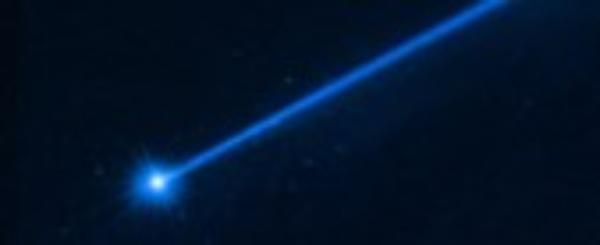What might the European Space Agency's Hera spacecraft find at the Didymos binary asteroid system?
On 26 September 2022, NASA’s Double Asteroid Redirection Test (DART) mission made its mark on asteroid Dimorphos, the moonlet of Didymos’ binary asteroid system, by smashing a 580 kg spacecraft at 6.6 km per second when Dimorphos was located 11 million km from Earth.
The success of this planetary defence technique, known as kinetic impact, demonstrated that we are a step closer to protect the Earth from potentially hazardous asteroids. It is the first time that the trajectory of an asteroid has been deliberately altered by a spacecraft.
“The DART mission has exceeded expectations” says Dr Stefania Soldini, Co-Investigator of DART. “Not only have we demonstrated that this technique works in space but the extra material that was been ejected after impact gave the asteroid an extra push. Dimorphos’s orbit around Didymos is now 33 minutes and 15 seconds shorter compared to our expectation of 73 seconds.”
This video shows the final five-and-a-half minutes of images leading up to the DART spacecraft’s intentional collision with asteroid Dimorphos. The DART spacecraft streamed these images from its DRACO camera back to Earth in real time as it approached the asteroid. This footage is 10 times faster than reality, except for the last six images, which are shown at the same rate that the spacecraft returned them.
The Hubble Space Telescope (HST) observed a trail of ejecta (37 boulders ranging in size from 1m to 6.7m across) drifting away from the asteroid, but there are plans to observe the system again in June 2024. “We might be able to still observe larger boulders that are leaving the system slowly. These observations will help to understand the scale of the DART impact and the asteroid’s composition.” explains Dr Soldini. “We will need to wait for the ESA’s Hera spacecraft to reach the system in 2026 to accurately measure what has happened.”

Ejecta tail observed by the Hubble Space Telescope (HJST). Credits: NASA/Johns Hopkins APL
ESA’s Hera mission, planned to be launched in October 2024, will be key in these studies. “Our team is going to ESA/ESTEC in the Netherlands to the annual Hera workshop to coordinate the science activities and mission operation planning.” says Dr Soldini, Co-I of ESA/Hera. The team led by Dr Soldini is working on several Hera’s mission studies such as looking into the dynamical environment of the system with Dr Xiaoyu Fu, as well as understanding the fate of DART impact ejecta with PhD student Flavia Saveriano and understanding the asteroid properties and composition with PhD student Henry Morten, who is co-supervised by Dr Soldini and Professor Monica D’Onofrio from the Department of Physics.
“My PhD research project is primarily focused on determining the most effective radio science strategy for detecting high order gravitational anomalies in asteroids, without being otherwise constrained by a traditional Earth-Spacecraft communication link.” says Henry Morton. “This will be crucial as one of the first mission operations that the Hera spacecraft is measuring the gravity field of Didymos and Dimorphos for a first understanding of the main properties of the asteroids. We will develop a software that enables spacecraft to self-estimate the internal structure of asteroids.”
This research is connected to Dr Soldini’s UKRI FLF funded REMORA project (Rendezvous Mission for Orbital Reconstruction of Asteroids) but also aims to use cutting-edge techniques to solve challenging engineering problems in astrodynamics. “The idea is to employ artificial intelligence (AI) methods that are usually adopted in high-energy physics data analysis to help reconstruct the asteroid’s density from limited engineering gravity data as measured by the Hera spacecraft,” says Professor Monica D’Onofrio, Head of Physics Research and UK-PI of a CHIST-ERA grant on AI and explainable AI in particle physics and medical science. “AI has revolutionised the way we study fundamental science. We have successfully applied these AI techniques to diverse fields, and the idea of applying them to study the dynamic of complex systems in space is very exciting”.
This PhD project, a collaboration between our Physics and Engineering Departments, is another example of the power of interdisciplinary collaborations through the application of advanced data science to diverse research fields. This approach has been pioneered by the Liverpool Centre for Doctoral Training for Innovation in Data Intensive Science (LIV.INNO), coordinated by Professor Carsten Welsch – an inclusive hub for training diverse cohorts of excellent students in data intensive science. Funded by STFC and hosted by the University of Liverpool and Liverpool John Moores University, LIV.INNO is focussed on addressing the data challenges presented by research in astronomy, nuclear, theoretical and particle physics, accelerator science, mathematical and computer science.
 Example of possible mass distribution of Didymos asteroid [Soldini, S., “The Effect of NEAs Internal Structure on Particle Dynamics: a way to Search for Stable Orbits around Asteroid Didymos”, in 7th IAA Planetary Defense Conference, 2021.]
Example of possible mass distribution of Didymos asteroid [Soldini, S., “The Effect of NEAs Internal Structure on Particle Dynamics: a way to Search for Stable Orbits around Asteroid Didymos”, in 7th IAA Planetary Defense Conference, 2021.]
Accurately estimating the density of an asteroid is of great importance for planetary science and planetary defence, helping to unlock our understanding of their formation, enhance our knowledge of the gravity environment around them, and improve the safety of spacecraft-asteroid proximity operations. The project is partially funded by ESA Open Space Innovation Platform (OSIP) and is conducted in collaboration with Dr Dario Izzo scientific coordinator of the ESA’s Advanced Concept Team which directly supports the ESA’s Hera radio science mission operations.
The launch of the Hera spacecraft will further advance our understanding of asteroids and provides an opportunity to further unlock our planetary defence capabilities.